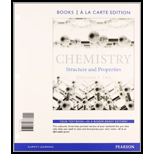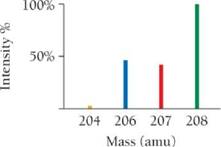
Chemistry: Structures and Properties, Books a la Carte Plus MasteringChemistry with eText -- Access Card Package
1st Edition
ISBN: 9780321974617
Author: Nivaldo J. Tro
Publisher: PEARSON
expand_more
expand_more
format_list_bulleted
Concept explainers
Textbook Question
Chapter 1, Problem 83E
Use the mass spectrum of lead shown here to estimate the

Expert Solution & Answer
Want to see the full answer?
Check out a sample textbook solution
Students have asked these similar questions
None
CH3
CH
H3C
CH3
H
OH
H3C-
-OCH2CH3
H3C
H
-OCH3
For each of the above compounds, do the following:
1. List the wave numbers of all the IR bands in the 1350-4000 cm-1 region.
For each one, state what bond or group it represents.
2. Label equivalent sets of protons with lower-case letters. Then, for each 1H NMR
signal, give the 8 value, the type of splitting (singlet, doublet etc.), and the number
protons it represents.
of
letter
δ value
splitting
# of protons
3. Redraw the compound and label equivalent sets of carbons with lower-case
letters.
Then for each set of carbons give the 5 value and # of carbons it represents.
letter
δ value
# of carbons
Draw the correct ionic form(s) of arginine at the pKa and PI in your titration curve. Use your titration curve to help you determine which form(s) to draw out.
Chapter 1 Solutions
Chemistry: Structures and Properties, Books a la Carte Plus MasteringChemistry with eText -- Access Card Package
Ch. 1 - Which statement is true about matter? a) Matter is...Ch. 1 - A chemist mixes sodium with water and witnesses a...Ch. 1 - Two samples of a compound containing elements A...Ch. 1 - A compound containing only carbon and hydrogen has...Ch. 1 - Which concept was demostrated by Rutherford’s gold...Ch. 1 - A student re-creates Millikan’s oil drop...Ch. 1 - Prob. 7SAQCh. 1 - An isotope of an element contains 82 protons and...Ch. 1 - How many electrons are in the Cr3+ ion? 24...Ch. 1 - A naturally occurring sample of an element...
Ch. 1 - Copper has an atomic mass of 63.55 amu and two...Ch. 1 - Which sample contains the greatest number of...Ch. 1 - Explain this statement in your own words and give...Ch. 1 - Explain the main goal of chemistry.Ch. 1 - What are two different ways to classify matter?Ch. 1 - How do solids, liquids, and gases differ?Ch. 1 - Explain the difference between a pure substance...Ch. 1 - Explain the difference between an element and a...Ch. 1 - Explain the difference between a homogeneous and a...Ch. 1 - Describe the scientific approach to knowledge. How...Ch. 1 - Prob. 9ECh. 1 - What observations did Antoine Lavoisier make? What...Ch. 1 - What theory did John Dalton formulate?Ch. 1 - What is wrong with the expression, “That is just a...Ch. 1 - Summarize the history of the atomic idea. How was...Ch. 1 - Prob. 14ECh. 1 - State and explain the law of definite proportions.Ch. 1 - State and explain the law of multiple proportions....Ch. 1 - What are the main ideas in Dalton’s atomic theory?...Ch. 1 - How and by whom was the electron discovered? What...Ch. 1 - Explain Millikan’s oil drop experiment and how it...Ch. 1 - Prob. 20ECh. 1 - Describe Rutherford’s gold foil experiment. How...Ch. 1 - Describe Rutherford’s nuclear model of the atom....Ch. 1 - If matter is mostly empty space, as suggested by...Ch. 1 - List the three subatomic particles that compose...Ch. 1 - What defines an element?Ch. 1 - Explain the difference between Z (the atomic...Ch. 1 - Where do elements get their names?Ch. 1 - What are isotopes? What is percent natural...Ch. 1 - Describe the two different notations used to...Ch. 1 - Prob. 30ECh. 1 - Prob. 31ECh. 1 - Explain how a mass spectrometer works. What kind...Ch. 1 - Each shape represents a type of particle (such as...Ch. 1 - Using triangles to represent one type of atom and...Ch. 1 - Classify each substance as a pure substance or a...Ch. 1 - Classify each substance as a pure substance or a...Ch. 1 - Prob. 37ECh. 1 - Complete the table. Substance Pure or mixture Type...Ch. 1 - Determine whether each molecular diagram...Ch. 1 - Determine whether each molecular diagram...Ch. 1 - Classify each statement as an observation, a law,...Ch. 1 - Classify each statement as an observation, a law,...Ch. 1 - A chemist decomposes several samples of carbon...Ch. 1 - When astronomers observe distant galaxies, they...Ch. 1 - Prob. 45ECh. 1 - An automobile gasoline tank holds 21 kg of...Ch. 1 - Two samples of carbon tetrachloride are decomposed...Ch. 1 - Two samples of sodium chloride are decomposed into...Ch. 1 - The mass ratio of sodium to fluorine in sodium...Ch. 1 - Upon decomposition, one sample of magnesium...Ch. 1 - Two different compounds containing osmium and...Ch. 1 - Palladium forms three different compounds with...Ch. 1 - Prob. 53ECh. 1 - Sulfur and fluorine form several different...Ch. 1 - Which statements are consistent with Dalton’s...Ch. 1 - Which statements are inconsistent with Dalton’s...Ch. 1 - Which statements are consistent with Rutherford’s...Ch. 1 - Which statements are inconsistent with...Ch. 1 - A chemist in an imaginary universe, where...Ch. 1 - Imagine a unit of charge called the zorg. A...Ch. 1 - Which statements about subatomic particles are...Ch. 1 - Which statements about subatomic particles are...Ch. 1 - Write isotopic symbols in the form XA (e g., C-13)...Ch. 1 - Write isotopic symbols in the form ZAX for each...Ch. 1 - Determine the number of protons and the number of...Ch. 1 - Determine the number of protons and the number of...Ch. 1 - The amount of carbon-14 in ancient artifacts and...Ch. 1 - Uranium-235 is used in nuclear fission. Determine...Ch. 1 - Determine the number of protons and the number of...Ch. 1 - Determine the number of protons and the number of...Ch. 1 - Gallium has two naturally occurring isotopes with...Ch. 1 - Magnesium has three naturally occurring isotopes...Ch. 1 - The atomic mass of fluorine is 18.998 amu, and its...Ch. 1 - The atomic mass of copper is 63.546 amu. Do any...Ch. 1 - An element has two naturally occurring isotopes....Ch. 1 - An element has four naturally occuring isotopes...Ch. 1 - Bromine has two naturally occurring isotopes...Ch. 1 - Silicon has three naturally occurring isotopes...Ch. 1 - Use the mass spectrum of europium shown here to...Ch. 1 - Use the mass spectrum of rubidium shown here to...Ch. 1 - A 7.83-g sample of HCN contains 0.290 g of H and...Ch. 1 - The ratio of sulfur to oxygen by mass in SO2 is...Ch. 1 - Use the mass spectrum of lead shown here to...Ch. 1 - Use the mass spectrum of mercury shown here to...Ch. 1 - Nuclei with the same number of neutrons but...Ch. 1 - Fill in the blanks to complete the table. Symbol z...Ch. 1 - Silver is composed of two naturally occurring...Ch. 1 - To the right is a representation of 50 atoms of a...Ch. 1 - The ratio of oxygen to nitrogen by mass in NO2 is...Ch. 1 - Naturally occurring cobalt consists of only one...Ch. 1 - A 7.36-g sample of copper is contaminated with an...Ch. 1 - The ratio of the mass of O to the mass of N in...Ch. 1 - Naturally occurring magnesium has an atomic mass...Ch. 1 - A volatile liquid (one that readily evaporates) is...Ch. 1 - The diagram to the right represents solid carbon...Ch. 1 - Use triangles to represent atoms of element A and...Ch. 1 - Identify each statement as being most like an...
Knowledge Booster
Learn more about
Need a deep-dive on the concept behind this application? Look no further. Learn more about this topic, chemistry and related others by exploring similar questions and additional content below.Similar questions
- Carbohydrates- Draw out the Hawthorne structure for a sugar from the list given in class. Make sure to write out all atoms except for carbons within the ring. Make sure that groups off the carbons in the ring are in the correct orientation above or below the plane. Make sure that bonds are in the correct orientation. Include the full name of the sugar. You can draw out your curve within the text box or upload a drawing below.arrow_forwardHow many milliliters of 97.5(±0.5) wt% H2SO4 with a density of 1.84(±0.01) g/mL will you need to prepare 2.000 L of 0.110 M H2SO4? If the uncertainty in delivering H2SO4 is ±0.01 mL, calculate the absolute uncertainty in the molarity (0.110 M). Assume there is negligible uncertainty in the formula mass of H2SO4 and in the final volume (2.000 L) and assume random error.arrow_forwardDon't used hand raiting and don't used Ai solutionarrow_forward
- * How many milliliters of 97.5(±0.5) wt% H2SO4 with a density of 1.84(±0.01) g/mL will you need to prepare 2.000 L of 0.110 M H2SO4? * If the uncertainty in delivering H2SO4 is ±0.01 mL, calculate the absolute uncertainty in the molarity (0.110 M). Assume there is negligible uncertainty in the formula mass of NaOH and in the final volume (2.000 L) and assume random error.arrow_forwardYou are tasked with creating a calibration curve for the absorbance of cobalt solutions of various concentrations. You must prepare 5 standards with concentrations between 1.00 mg/L and 10.0 mg/L Co2+. You have a stock solution with a concentration of 40 mg/L Co2+ and all the standard lab glassware including transfer pipets and flasks. Explain how you would make your 5 standard solutions of various concentrations, including what glassware you would use to measure and prepare each solution.arrow_forwardPredict the product and write the mechanism. CH3-CH=CH-CH2-CH3 + NBS- hv CCl4arrow_forward
arrow_back_ios
SEE MORE QUESTIONS
arrow_forward_ios
Recommended textbooks for you
 Chemistry: An Atoms First ApproachChemistryISBN:9781305079243Author:Steven S. Zumdahl, Susan A. ZumdahlPublisher:Cengage Learning
Chemistry: An Atoms First ApproachChemistryISBN:9781305079243Author:Steven S. Zumdahl, Susan A. ZumdahlPublisher:Cengage Learning Chemistry: The Molecular ScienceChemistryISBN:9781285199047Author:John W. Moore, Conrad L. StanitskiPublisher:Cengage Learning
Chemistry: The Molecular ScienceChemistryISBN:9781285199047Author:John W. Moore, Conrad L. StanitskiPublisher:Cengage Learning ChemistryChemistryISBN:9781305957404Author:Steven S. Zumdahl, Susan A. Zumdahl, Donald J. DeCostePublisher:Cengage Learning
ChemistryChemistryISBN:9781305957404Author:Steven S. Zumdahl, Susan A. Zumdahl, Donald J. DeCostePublisher:Cengage Learning
 Chemistry & Chemical ReactivityChemistryISBN:9781337399074Author:John C. Kotz, Paul M. Treichel, John Townsend, David TreichelPublisher:Cengage Learning
Chemistry & Chemical ReactivityChemistryISBN:9781337399074Author:John C. Kotz, Paul M. Treichel, John Townsend, David TreichelPublisher:Cengage Learning Chemistry: Principles and PracticeChemistryISBN:9780534420123Author:Daniel L. Reger, Scott R. Goode, David W. Ball, Edward MercerPublisher:Cengage Learning
Chemistry: Principles and PracticeChemistryISBN:9780534420123Author:Daniel L. Reger, Scott R. Goode, David W. Ball, Edward MercerPublisher:Cengage Learning

Chemistry: An Atoms First Approach
Chemistry
ISBN:9781305079243
Author:Steven S. Zumdahl, Susan A. Zumdahl
Publisher:Cengage Learning

Chemistry: The Molecular Science
Chemistry
ISBN:9781285199047
Author:John W. Moore, Conrad L. Stanitski
Publisher:Cengage Learning

Chemistry
Chemistry
ISBN:9781305957404
Author:Steven S. Zumdahl, Susan A. Zumdahl, Donald J. DeCoste
Publisher:Cengage Learning


Chemistry & Chemical Reactivity
Chemistry
ISBN:9781337399074
Author:John C. Kotz, Paul M. Treichel, John Townsend, David Treichel
Publisher:Cengage Learning

Chemistry: Principles and Practice
Chemistry
ISBN:9780534420123
Author:Daniel L. Reger, Scott R. Goode, David W. Ball, Edward Mercer
Publisher:Cengage Learning
Mass Spectrometry; Author: Professor Dave Explains;https://www.youtube.com/watch?v=hSirWciIvSg;License: Standard YouTube License, CC-BY